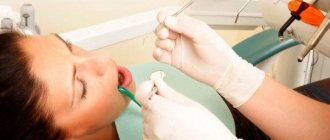How long does it take for flux to last after tooth extraction?
Swelling of the gums after tooth extraction continues for varying periods of time. The duration depends on the chosen method of surgery, the condition of the oral cavity and the immune abilities of the patient’s body. On average, swelling subsides in 3-4 days, sometimes lasting up to 7 days. Complications are indicated by persistence of flux for more than a week. Swelling appears 2-3 hours after the operation; along with it, the anesthesia wears off and pain may occur. Sometimes the cessation of anesthesia is accompanied by a slight increase in temperature. Therefore, the dentists at Dr. Fedorov’s clinic prescribe painkillers.
Maximum swelling is observed on the third or fourth day. By the seventh day it should completely go away. It's not just the gums that can become swollen. If your cheek is inflamed after tooth extraction, most likely the process began to develop before the operation.
What to do if your gums are swollen after tooth extraction
Monitor your body's condition throughout the week. It is recommended to make an appointment with a doctor if:
- On the fourth day after surgery, the swelling did not decrease, but rather increased.
- A sharp throbbing pain occurs in the jaw, gum or cheek area - not to be confused with the aching pain that appears after the anesthesia wears off.
- The temperature rose to 38℃ and did not subside throughout the day.
- There is a feeling of persistent weakness and general malaise of the body.
- There is pain in the throat when swallowing.
If your gums are simply swollen after tooth extraction and there are no complications listed above, follow the recommendations received from your dentist. The swelling will completely go away within a week.
On the second day after tooth extraction, my cheek became swollen
The cheek does not always swell immediately after the patient’s gum is cut. Swelling may occur the next day - this is also natural. There may be no swelling of the cheek at all; often only the gums suffer. Moreover, everything is normal if postoperative recovery proceeds with the following introductory notes:
- body temperature on the second day is normal - not elevated;
- no sharp, throbbing pain in the gums;
- a day after the onset of swelling began to gradually decrease.
Flux on the gums: causes
The situation when a person’s gums are swollen can be associated mainly with three factors: the lack of timely treatment of caries and pulpitis, poor-quality treatment of pulpitis and periodontitis in the past, as well as the presence of concomitant inflammation of the gums.
- Untreated caries and pulpitis – if caries is not treated for a long time, then the infection from the carious cavity penetrates into the dental pulp, where inflammation develops. Pulpitis is characterized by acute or aching spontaneous pain in the tooth. If at this stage you also do not go to the dentist, then the inflammation progresses and the infection goes beyond the dental pulp - into the tissue surrounding the tooth. As a result, purulent inflammation develops around the tops of the roots of such a tooth - Periodontitis (Fig. 4a).
With periodontitis, a so-called periodontal abscess (in common parlance – a purulent sac) forms in the area of the root apex. With active inflammation, intensive formation of pus occurs, which leads to the release of pus under the mucous membrane of the gums (Fig. 4b). After the pus releases into the soft tissues, a person immediately feels that his gums are swollen, i.e. flux has formed. As a rule, flux is combined with swelling of the soft tissues of the face.Case from practice: development of gumboil in the upper jaw → In Fig. 5 you can see a patient who came to the dentist with complaints of swelling of the cheek and gums. An external examination reveals facial asymmetry due to swelling, as well as painful hardening of the soft tissues of the cheek (shown by arrows). → When examined in the oral cavity (Fig. 6), we see that swelling of the gums is determined along the transitional fold (shown by white arrows), and in the projection of the swelling there is a half-destroyed tooth (shown by a black arrow). → In Fig. 7 we see an x-ray of the causative tooth: there is a darkening in the area of the root apex, which indicates the presence of a periodontal abscess.
- Poorly filled root canals – periodontal abscess at the apex of tooth roots can form not only in the absence of timely treatment of caries and pulpitis, but also in the event of poor-quality root canal treatment. It is customary to fill root canals in the treatment of pulpitis, periodontitis, and in preparing teeth for prosthetics.
If the root canals are not filled to the apex of the root, then conditions for the development of infection are created in the unfilled part of the root canal. In this area, the pathogenic microflora gradually multiplies and then spreads beyond the boundaries of the tooth. As a result, in the area of the root tips, the canals of which were poorly sealed, a focus of purulent inflammation (periodontal abscess) appears.Analysis of the quality of root canal filling using radiographs –
- In Fig. 8-9 you can see poorly treated root canals. The unfilled parts of the canals are marked with white arrows. The focus of purulent inflammation (periodontal abscess) on x-ray looks like a pronounced darkening at the root apex (limited by black arrows).
- In Fig. 10 you can see how well-filled root canals look on an x-ray. Black arrows mark the apexes of the roots of the three lower incisors. Please note that each of the three teeth is filled to the top of the root.
- Swelling of the gums during exacerbation of periodontitis – with periodontitis, the tooth-gingival attachment is destroyed between the tooth root and the gum, and thus periodontal pockets appear (Fig. 11). On the surface of the root in such a periodontal pocket there are almost always hard subgingival dental deposits, and the pocket itself is filled with granulations and pus. If the pocket is deep enough, the outflow of pus from it may be impaired. In this case, a swelling or fistula occurs in the projection of the pocket on the gum.
In Fig. 12 you can see a periodontal abscess on the gum in the projection of the upper central incisor (24stoma.ru). Probing of this tooth revealed a periodontal pocket of about 8 mm. On the x-ray of this tooth (Fig. 13) we can see that the depth of the pocket (depth of bone destruction) in the interdental space is more than 2/3 of the length of the root.
Reasons why the cheek swells after tooth extraction
Swelling appears due to the inflammatory process occurring in the mucosa and pulp after surgery. This is a non-infectious inflammation. If operations are carried out correctly and the surgeon’s instructions are followed, the swelling goes away painlessly and without the need to take antibiotics. The integrity of the oral mucosa is disrupted during doctor intervention. The more swollen the gums are after tooth extraction, the more the integrity of the mucous membrane is damaged.
Severe swelling most often appears in patients who have had their wisdom teeth extracted - they generally have large, intertwined roots that complicate the process. The same applies to situations where inflammation began before surgery.
Cheek swelling during wisdom tooth removal
Working with outer teeth is a complex operation. Therefore, swelling always occurs after wisdom teeth removal. Doctors often resort to cutting the gums, after which they apply stitches.
For two to three days after surgery, the temperature may remain above 37℃, and opening the mouth, talking and swallowing may be accompanied by pain. The risk of infection and serious inflammation is higher than with other tooth extractions. The surgeon must prescribe baths with an antiseptic solution and antibiotics. Additionally, it is recommended to eat soft, pureed foods at room temperature, and refrain from sweets, alcohol and smoking.
Treatment
It is important to understand that gumboil cannot be cured in one day. It is necessary to prepare for at least a week of treatment. It is very important to use only those treatment methods prescribed by a specialist, and not use dubious folk remedies and advice on forums on the Internet.
Self-medication is dangerous with complications!
Attention
Despite the fact that our articles are based on trusted sources and have been tested by practicing doctors, the same symptoms can be signs of different diseases, and the disease may not proceed according to the textbook.
Pros of seeing a doctor:
- Only a specialist will prescribe suitable medications.
- Recovery will be easier and faster.
- The doctor will monitor the course of the disease and help avoid complications.
find a doctor
Do not try to treat yourself - consult a specialist.
All treatment is divided into several main stages.
Visit to the dentist
This part is mandatory, since this is where the examination is carried out and further treatment is prescribed, even if it does not require surgical intervention. However, at some stages the flux must be opened.
In this case, the dentist cleans the gums and bone tissue. If the flux has already burst, the doctor cleans out the purulent masses through a special incision. If the abscess is still mature, then the pus is removed through drainage.
Drug treatment
One of the most important components of successful treatment is antibiotics. You should use only those medications prescribed by your doctor. In addition to antibiotics, anti-inflammatory, antihistamine and painkillers are prescribed.
External treatment
This method is auxiliary, but no less effective. Tissue treatment is necessary in order to relieve inflammation and destroy microbes.
Prevention
This is one of the most important parts of treatment and is especially effective in preventing relapses. In addition to careful oral hygiene, it is necessary to eliminate the cause of the primary disease.
If it was caries, then the affected tooth should be removed. If the flux is the result of a sore throat, then it is necessary to take a course of vitamins and immunomodulators that will help avoid this disease in the future. It is also necessary to visit the dentist several times a year solely for preventive purposes.
Other causes of cheek swelling
If you have a tooth removed and your gums are swollen, the cause does not necessarily lie in soft tissue damage. Swelling is possible due to the following:
- performing an operation if the patient has a flux;
- complex course of the operation - due to tooth growth in the wrong direction, strong inclination, removal of large teeth with large, intertwined roots;
- inflammation and infection of soft tissues or tooth roots before surgery;
- allergies or other forms of individual intolerance to anesthesia and medications used during removal - therefore it is important to know exactly what components you are allergic to before removal;
- poor antiseptic treatment of the oral cavity and mistakes made by the doctor during tooth extraction;
- chronic diseases leading to complicated recovery - neuralgia, hypertension, as well as a general decline in the body’s immune functions;
- ignoring prescriptions received from the dentist - for example, independently adjusting the dosage or deciding not to take antibiotics.
Most often, patients' swelling does not subside after tooth extraction due to lack of normal care - skipping medications, complete absence or insufficiently frequent disinfection treatment.
Possible complications
Patients face complications due to incorrect care, complex or incorrect removal. Dentistry distinguishes 5 types of complications:
- Alveolitis - to put it simply, this is dryness of the socket. A blood clot always forms in the latter. It does not need to be removed, since the clot protects soft tissues from the penetration of bacteria and infection. If it is accidentally removed, the mucous membrane becomes susceptible to the pathogenic influence of bacteria, and suppuration may develop. Sometimes the inflammation shifts and spreads - a large area of the jaw, cheekbones and eyes become inflamed.
- Osteomyelitis is bone inflammation. With osteomyelitis, acute pain is felt in the upper and lower jaw, and swelling only increases.
- An abscess is suppuration inside the gum. Can move, leading to loosening of the tooth root.
- Flux is a severe inflammation of the jaw, in which the temperature rises and acute pain appears in the area of the jaw and temples.
- Neuritis is an inflammation in which the motor activity of the facial nerve is disrupted. Neuritis is indicated by swelling of the cheek, palate, tongue and larynx.
What happens if flux is not treated?
The lump needs to be treated immediately! In an advanced stage, therapy will be longer, more complex, and multiple complications are possible. You cannot wait, as the disease causes dangerous consequences:
- A large palatal abscess smooths out the transverse folds, increases inflammation, which makes swallowing difficult.
- Sometimes the capsule ruptures and the pus spreads out. This leads to infection entering the blood, spreading throughout the body and causing sepsis.
- Extensive bumps prevent chewing.
- Tissue death in the affected area is possible.
- Conversation and movement of the jaw becomes difficult.
- In the fulminant form of severe sepsis, a person may die without treatment.
To prevent an abscess, constant prevention of caries is necessary. To avoid the appearance of a lump, you should get rid of foci of bacterial inflammation in a timely manner. To prevent oral diseases, it is necessary to systematically carry out hygiene procedures in the dentist’s office. Preventive examinations should be done once every six months.
How to eliminate cheek swelling
It is impossible to get rid of edema 100% before the inflammatory process stops. To reduce discomfort and pain, you can apply cooling compresses for 7-10 minutes with a break of 30-40 minutes. Taking painkillers, baths and rinsing with soothing solutions at room temperature helps.
How to remove cheek swelling after tooth extraction at home
- Avoid contact with the hole. It should not be touched with the tongue, brushed, or allowed to get in contact with food.
- Adhere to dietary restrictions. You should not eat or drink for 4 hours after removal. In the next week, food should be soft, at room temperature, not hot or spicy. Eating sweets is not advisable.
- In the first 3-4 hours after removal, apply cooling compresses to the cheek. It is optimal to keep the compress for 3-5 minutes, maximum – 10-15. The compress can only be done on the first day.
- Rinse your mouth with an antiseptic solution. The main thing is to follow all the dentist’s instructions.











